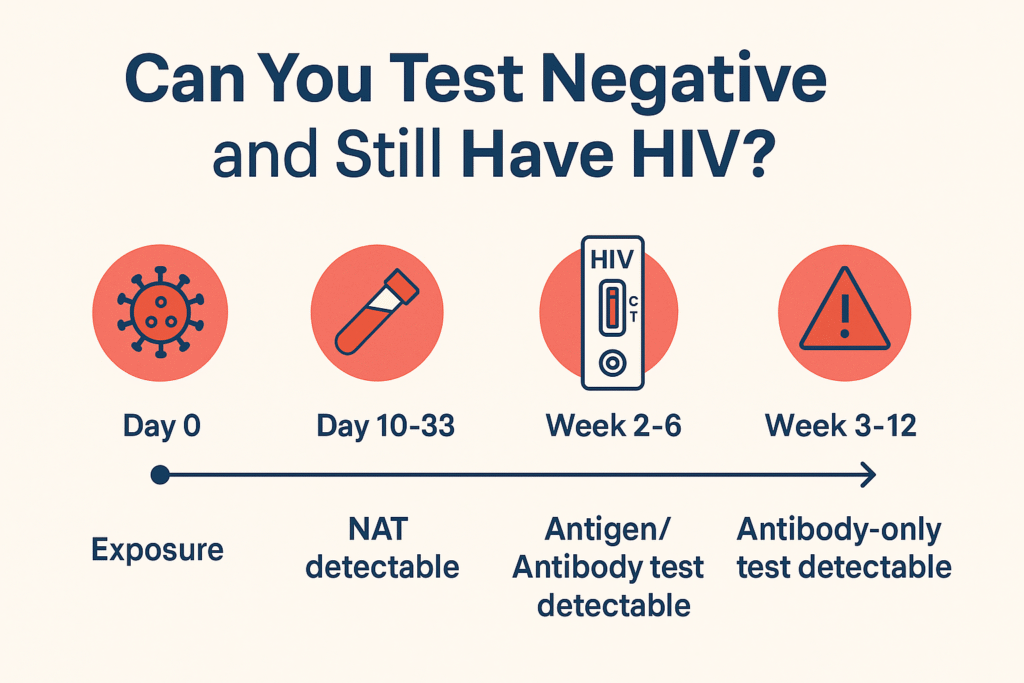
Understanding False Negatives and Early Detection
When it comes to HIV testing, a negative result often brings relief. But what happens when symptoms persist or exposure was recent? Is it possible to test negative and still have HIV? The short answer is yes, and understanding why is crucial to your health, relationships, and peace of mind.
What Does a Negative HIV Test Mean?
An HIV test looks for the presence of the virus (or the antibodies your body produces in response). A negative result typically means:
- No HIV was detected in your body at the time of testing.
- You may not be infected or you may be in the window period where the virus is undetectable.
But here’s the catch: timing matters.
What Is the HIV Window Period?
The HIV window period is the time between exposure to the virus and the point when a test can reliably detect it.
Key points:
- Antibody tests: These usually detect HIV 3 to 12 weeks after exposure.
- Antigen/antibody tests (4th generation): Detect HIV within 2 to 6 weeks.
- Nucleic Acid Tests (NATs): Can detect HIV as early as 10 to 33 days after exposure.
During the window period, someone can be infected with HIV and still test negative. They can also transmit the virus to others.
Factors That Can Cause a False Negative
Several factors can cause a false-negative HIV test result:
- Testing too early (before antibodies or antigens are detectable)
- Low viral load during acute infection
- Improper sample collection
- Test sensitivity or technical error
- Immunosuppressive conditions or medications
In rare cases, even people with HIV may take longer to develop detectable antibodies, especially if they have a weakened immune system.
When Should You Get Retested for HIV?
If you believe you’ve been exposed to HIV, follow these testing guidelines:
- Immediately after exposure: Consider a NAT test for early detection.
- 3 to 6 weeks after: Take a 4th generation test.
- 3 months post-exposure: Get retested to confirm your status.
If you continue to have symptoms (e.g., fever, fatigue, swollen lymph nodes, rash), consult a healthcare provider regardless of your test result.

Common Symptoms of Early HIV Infection
Early HIV infection can mimic other viral illnesses. Common signs include:
- Fever
- Fatigue
- Muscle aches
- Swollen glands
- Sore throat
- Rash
These symptoms may appear 2 to 4 weeks after exposure and disappear quickly, leading people to overlook them.
How to Reduce the Risk of a False Negative
- Wait for the appropriate window period before testing
- Use reliable, high-sensitivity tests like 4th generation or NATs
- Avoid self-testing too early
- Speak to a healthcare professional for proper timing and test selection
What to Do If You Still Suspect HIV After a Negative Test
If your symptoms persist or you had a high-risk encounter, you should:
- Retest after the window period
- Request a different type of HIV test
- Get tested for other STIs
- Avoid unprotected sex until your status is confirmed
Remember, early detection saves lives. The sooner HIV is diagnosed, the sooner treatment can begin.
Prevention and Next Steps
Regardless of your test result, always practice safe sex and take preventative steps:
- Use condoms consistently
- Consider PrEP (Pre-Exposure Prophylaxis) if you’re at ongoing risk
- Get tested regularly
- Encourage your partners to get tested
Final Thoughts
Yes, it is entirely possible to test negative and still have HIV—especially if the test is taken too soon after exposure. False negatives are rare, but they do happen. That’s why understanding the window period, choosing the right test, and knowing when to retest are critical.
Protect your health by staying informed, taking timely action, and seeking medical guidance when needed.
FAQs: Can You Test Negative and Still Have HIV?
1. Can a negative HIV test be wrong?
Yes, especially if taken during the window period or due to a test error.
2. How long after exposure should I test for HIV?
Initial test at 2-6 weeks (4th generation), and again at 3 months to confirm.
3. What is the most accurate HIV test?
NATs are the most accurate in early infection, followed by 4th generation tests.
4. Can symptoms show up before a positive test?
Yes, symptoms can appear before HIV is detectable by some tests.
5. Should I keep testing if I feel sick after a negative result?
Yes. Follow up with your healthcare provider and retest if symptoms persist.
Take charge of your health. If you’ve had recent exposure, get tested and stay informed. Early action makes all the difference.



